These designers care not only about their jewelry’s look, but also about where it came from, how it’s made, and what it supports
Photography by Joel Stans
Prop stylist Alex Brannian
Jewelry editor Rima Suqi
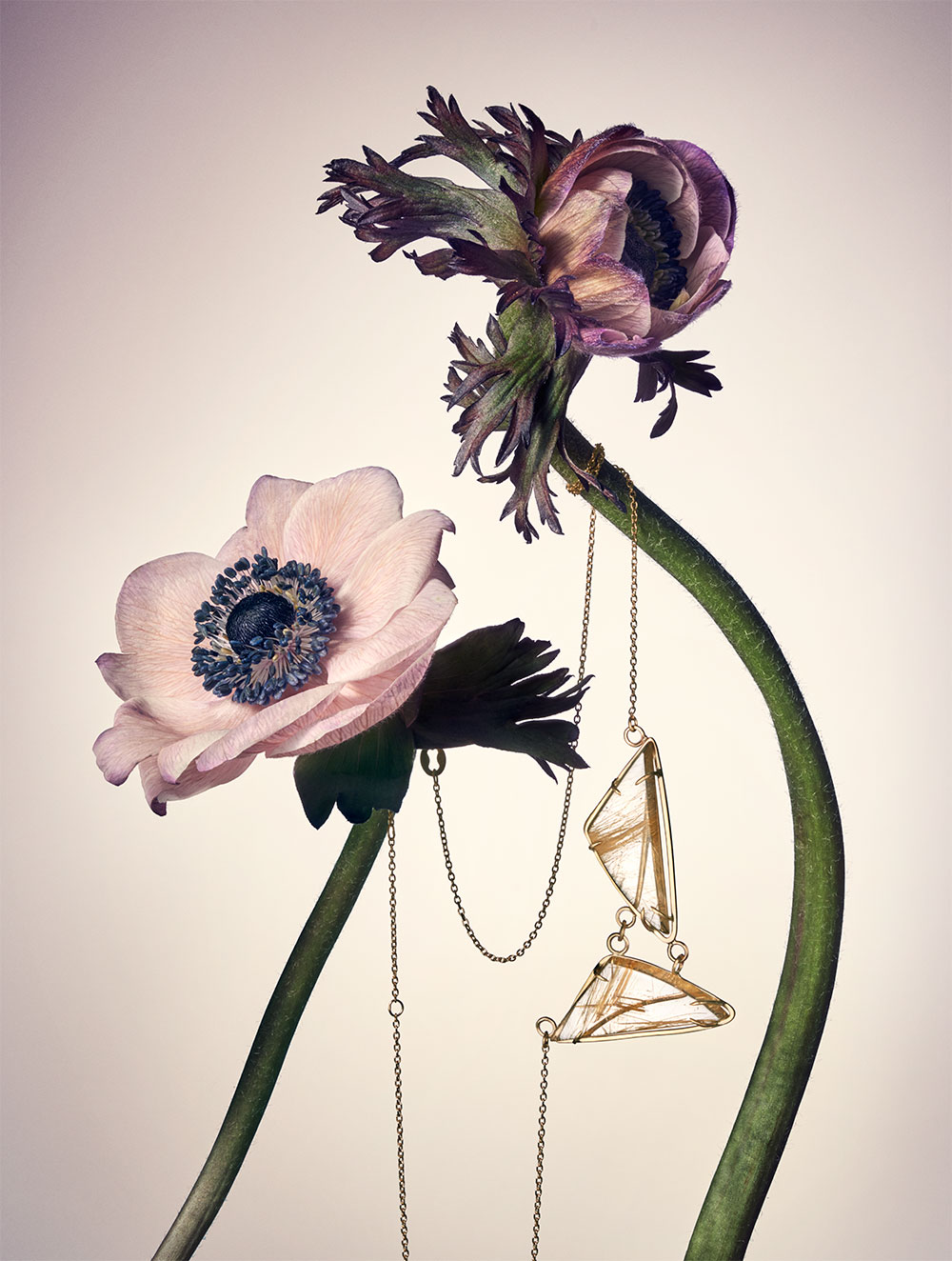 Altana necklace in 14k recycled yellow gold with 11 cts. t.w. rutilated quartz; $1,765; Enji Studio Jewelry; 858-381-0413; enjistudiojewelry.com
Altana necklace in 14k recycled yellow gold with 11 cts. t.w. rutilated quartz; $1,765; Enji Studio Jewelry; 858-381-0413; enjistudiojewelry.com
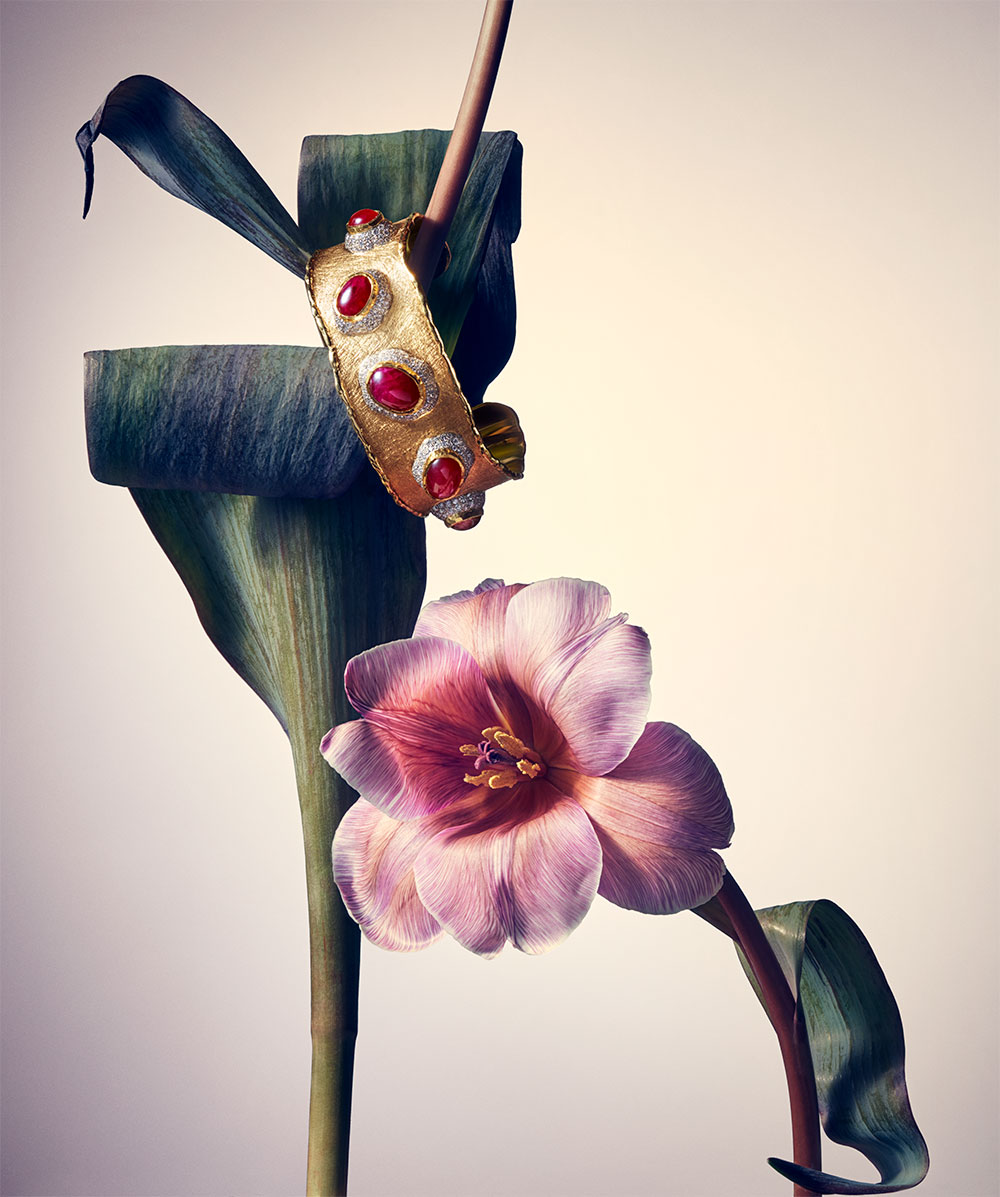 24k and 18k yellow gold cuff with 21.21 cts. t.w. responsibly mined Greenland rubies and 3.83 cts. t.w. diamonds; $85,800; Victor Velyan; 213-955-5950; victorvelyan.com
24k and 18k yellow gold cuff with 21.21 cts. t.w. responsibly mined Greenland rubies and 3.83 cts. t.w. diamonds; $85,800; Victor Velyan; 213-955-5950; victorvelyan.com
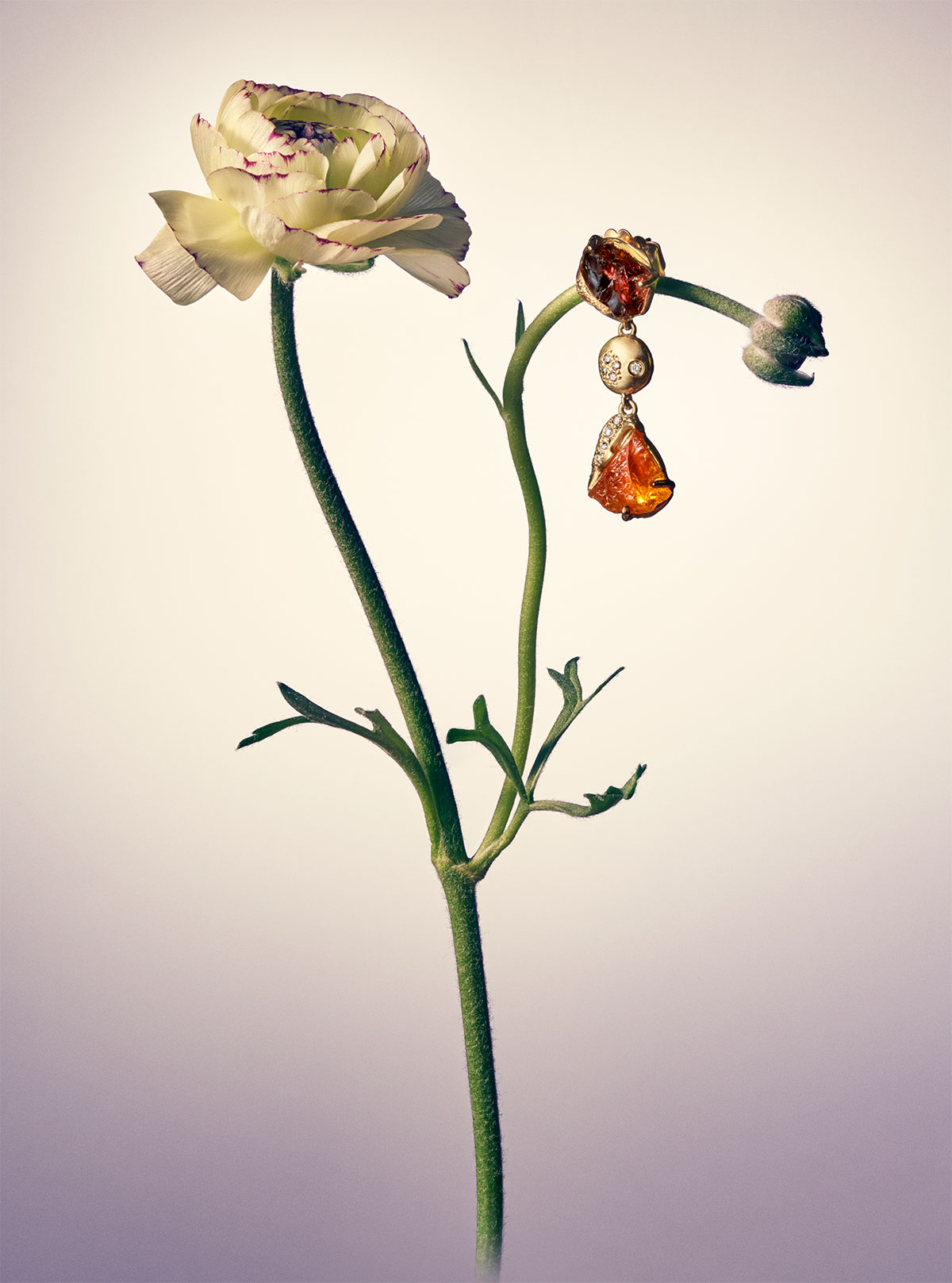 Rachel earrings in 18k recycled yellow gold with 7.55 cts. t.w. Tenda-cut pink tourmaline and 7.1 cts. t.w. spessartine; $5,680 (sold as a pair); Debra Navarro; 316-871-0569; debranavarro.com
Rachel earrings in 18k recycled yellow gold with 7.55 cts. t.w. Tenda-cut pink tourmaline and 7.1 cts. t.w. spessartine; $5,680 (sold as a pair); Debra Navarro; 316-871-0569; debranavarro.com
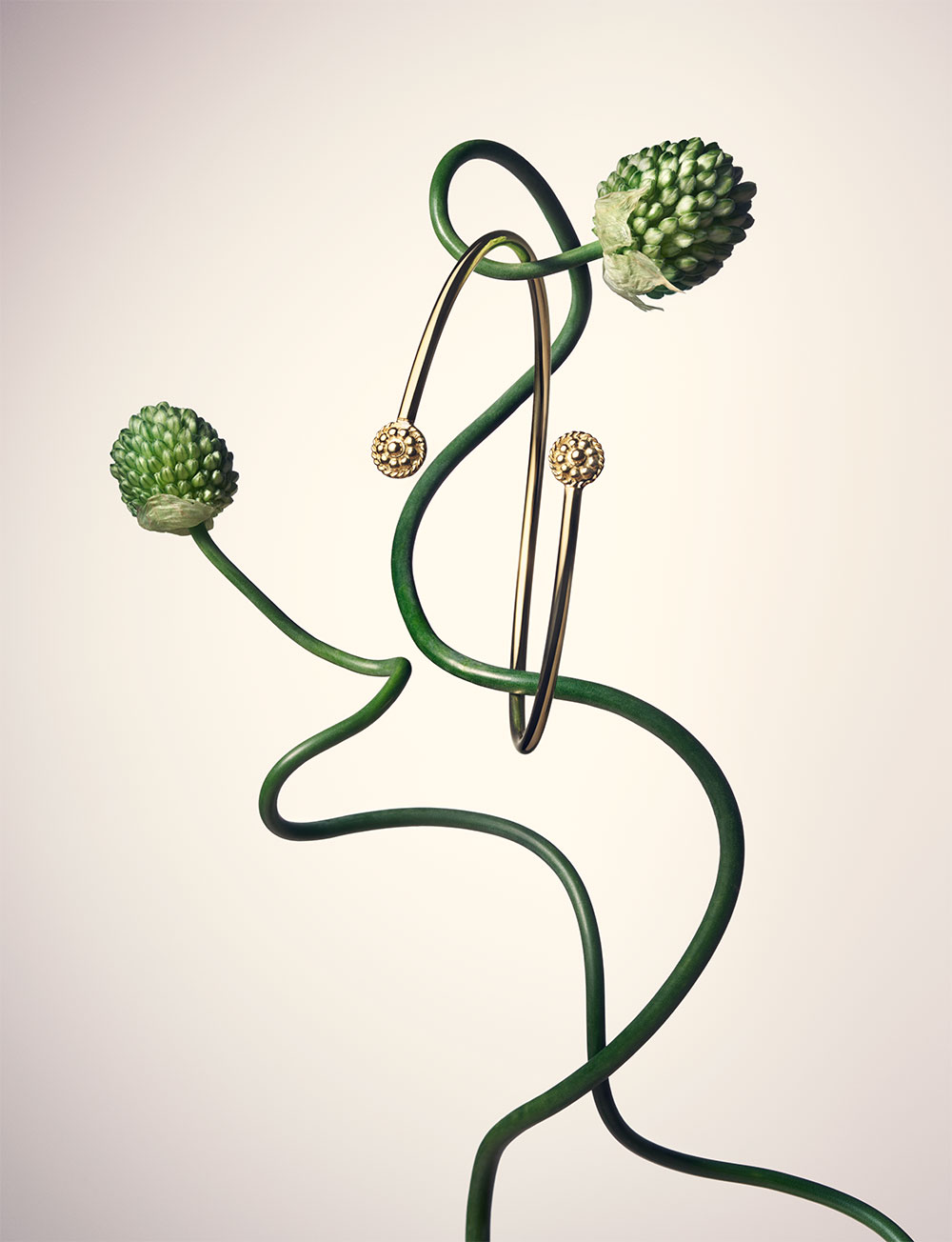 Flower twist bracelet in recycled, certified conflict-free 18k yellow gold; $1,900; Christina Malle; 917-488-9338; christinamalle.com
Flower twist bracelet in recycled, certified conflict-free 18k yellow gold; $1,900; Christina Malle; 917-488-9338; christinamalle.com
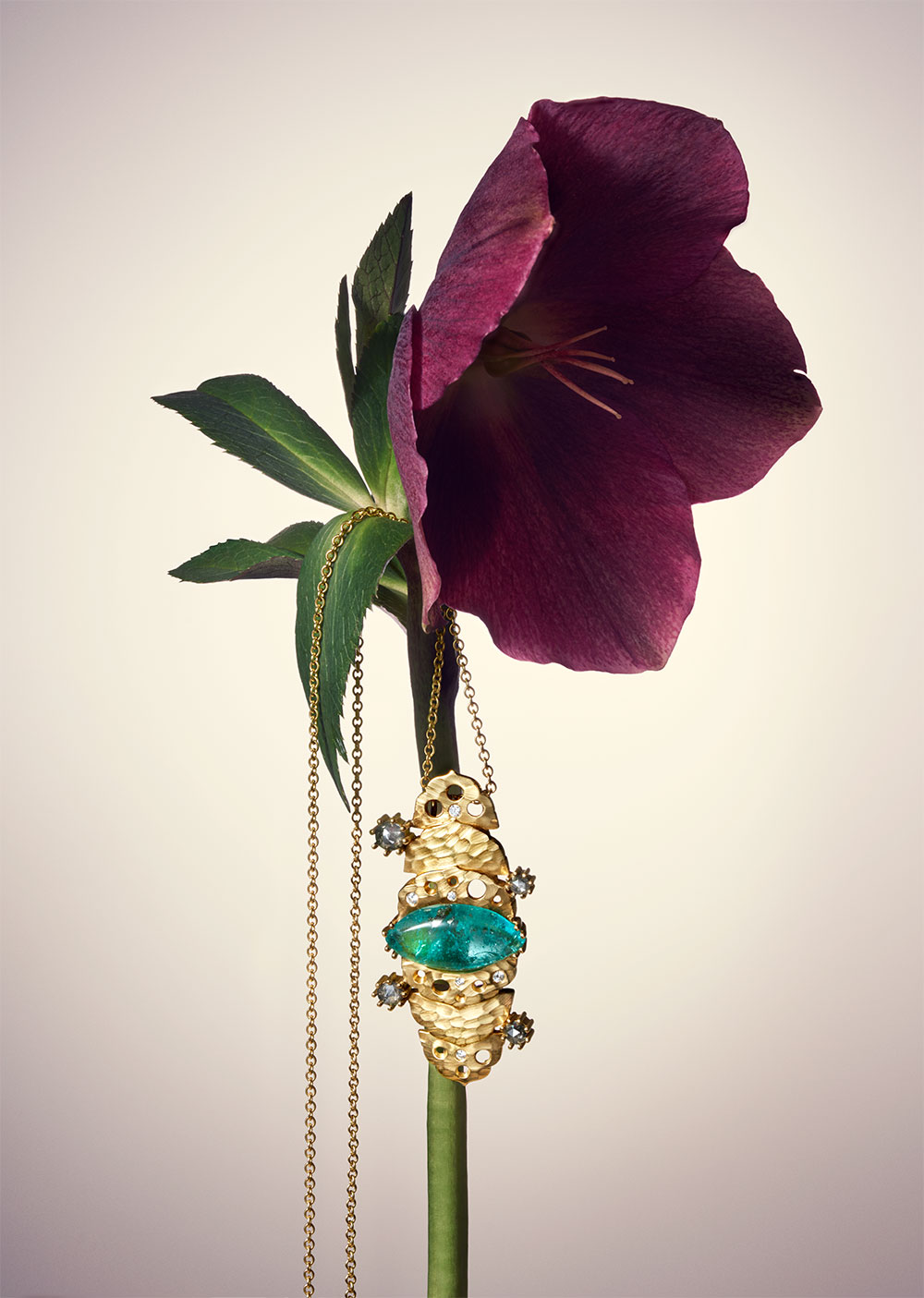 Agra pendant in 18k hand-hammered fair-mined yellow gold with 4.98 ct. marquise cabochon fair-trade Muzo emerald, 0.78 ct. t.w. rose-cut natural black diamonds, and 0.09 ct. t.w. melee; $5,185; Dana Bronfman; sales@danabronfman.com; danabronfman.com
Agra pendant in 18k hand-hammered fair-mined yellow gold with 4.98 ct. marquise cabochon fair-trade Muzo emerald, 0.78 ct. t.w. rose-cut natural black diamonds, and 0.09 ct. t.w. melee; $5,185; Dana Bronfman; sales@danabronfman.com; danabronfman.com
Today’s shoppers aren’t just looking at your products. they’re looking at your business model, too.
According to the 2017 Cone Communications CSR Study, 78 percent of American consumers want companies to address important social justice issues, and 87 percent will purchase a product because a company advocated for an issue they cared about. Companies that don’t take a stand risk losing revenue: The same study found that 76 percent of U.S. consumers will refuse to purchase a company’s products or services upon learning it supported an issue contrary to their beliefs.
Whether it’s by using recycled metals and gemstones, getting rid of dangerous chemicals, or rethinking packaging, an increasing number of jewelry designers and retailers are adopting sustainable practices. And as more industry pros join the cause, the challenges they once faced are falling away.
“When I started using recycled metals, there was only one refiner, so I was buying scrap and refining it myself,” says Aran Galligan, who founded the Seattle-based eco-conscious brand Aide-mémoire Jewelry in 2012. “The thing I’m excited about is that as there’s more awareness around green practices, more environmentally responsible materials are becoming available.”
Galligan is very strict about material sourcing. “We work with recycled precious metals, and as far as diamonds go, we typically use only recycled or lab-grown,” she explains. “If we use newly mined, they’re Canadian or Australian, where there are more restrictions around the mining, such as making sure people are paid decent wages.”
Kate Maller, founder of Kate Maller Jewelry, has a background in architecture and holds the Leadership in Energy and Environmental Design (LEED) professional credential. “When I decided to start making jewelry products and launched my line, I wanted to carry those values over,” says Maller, who lives and works in Denver. “Sustainability is one of my core principles.”
Maller uses reclaimed metals and gems that are recycled or from fair-trade sources. “We commit that 100 percent of our materials are from ethical sources,” she says. “Demand is growing, and the market is changing for jewelers with what you can buy. It’s similar to what happened in architecture.”
The Green Trend
With a growing number of global consumers buying or boycotting brands based on their beliefs, there is a clear desire for responsibly sourced and sold products, says Andrew Bone, former executive director at the Responsible Jewellery Council (RJC). “For larger retailers, adopting sustainable practices can be a demonstration of leadership,” he says, “building on their CSR [corporate social responsibility] credentials and showing due diligence to suppliers, partners, investors, and shop-floor customers.”
For smaller retailers, sustainability offers a competitive edge in the market, from both an employer and customer perspective. Everything from the increased investment into socially responsible companies to the boom in ethical retail over the past 10 years indicates positive change, Bone says. “The RJC has seen membership grow on average 20 percent each of the past five years to over 1,100 members today, suggesting the combined appetite not just for sustainable and responsible practices but for a community across our industry.”
How to Adopt Sustainable Practices
More than 90 percent of CEOs state that sustainability is important to their company’s success, according to the Stanford Social Innovation Review. But it can be difficult to know where to begin. The starting point is to become informed, says Christine Dhein, author of Eco Jewelry Handbook: A Practical Guide for a Healthy, Safe, and Sustainable Studio.
“I believe most jewelers want to do what’s right, but they don’t know the impact of their actions or they don’t know what a better choice would be,” she says. “I like to share information about better choices for material sourcing as well as about chemicals in the studio and how to protect your health.”
Ethical standards are a personal matter, adds Dhein, with the three main areas being environmental, political, and social. “Some people will be most concerned about pollution, others with child labor, and others with social justice,” she says. “Where are your priorities and where are you willing to draw lines? Outline the issues that are important to you so you can decide where to start.”
Once you set standards, use them to create sourcing policies. You can work with current suppliers to meet those requirements or look for alternatives. Groups such as RJC and Ethical Metalsmiths offer resources to jewelers who want to purchase fair-trade gold that supports miners who treat employees fairly, with a fair wage organized in a democratic way.
Sustainability also involves the techniques and chemicals you use, and Dhein suggests seeking less toxic substitutes. Galligan, for example, has focused on using as little plastic as possible. Consider practices that conserve resources in the studio, such as electricity and packaging, as well.
“We do a lot of green practices, such as printing on tree-free paper made from a byproduct of sugar,” Galligan says. “We don’t use paper towels, we purchase recycled toilet paper, use organic and natural cleaning products, and recycle and compost as much as we can. We haven’t found a plastic-free solution for ring boxes—yet.”
Responsible and sustainable business practices begin at home, Bone says. “Jewelers should be asking the right questions and doing their due diligence on partners throughout the supply chain.”
If going green seems like an overwhelming task, start with one area, such as material sourcing, suggests Dhein. “Break it down, review what you are using, and figure out how to take manageable steps to source materials [or change] studio practices. Then tackle another area.”
Share Your Efforts
Make customers aware of your sustainable practices through in-store signage and on your website. It’s also important to educate staff members on your mission and standards, as they’re the ones operating face-to-face each day with customers, adds Bone.
About half of Maller’s clients found her because they were looking for sustainable jewelry. “The others liked our designs, and having a conversation gives us a chance to educate them on sustainable jewelry,” she says.
Likewise, Galligan reports that a lot of Aide-mémoire customers discovered the brand while searching for ethical jewelers. “Across the board, consumers are looking at businesses and their practices,” she says. “They want to know if [companies are] doing business in an ethical way, or if they are all about making money. I see a big change, with more jewelers becoming aware of issues and being more ethical in their practices.”